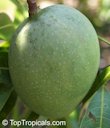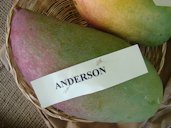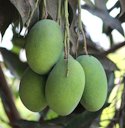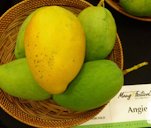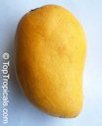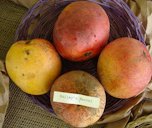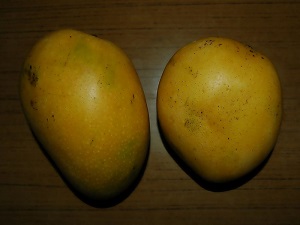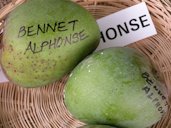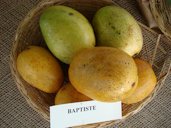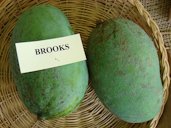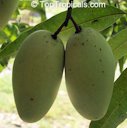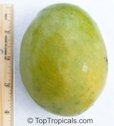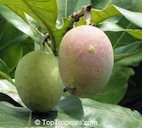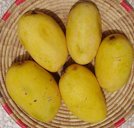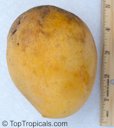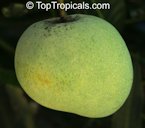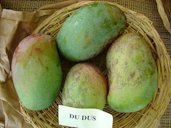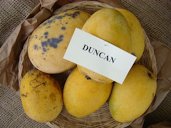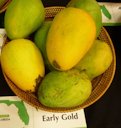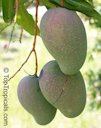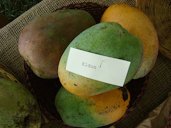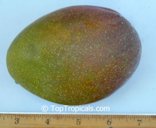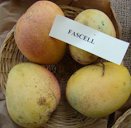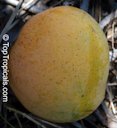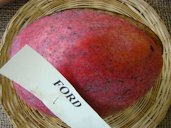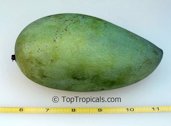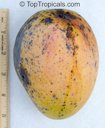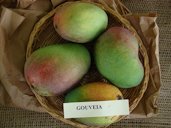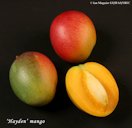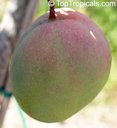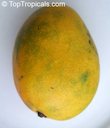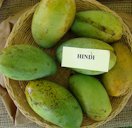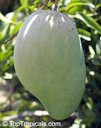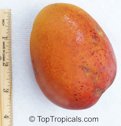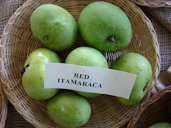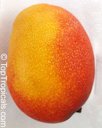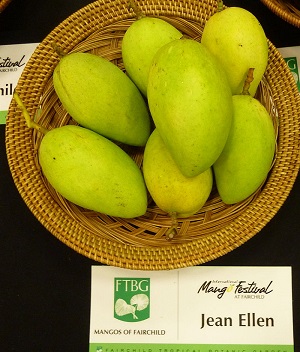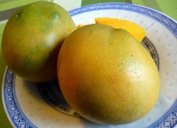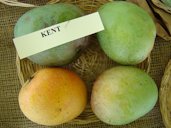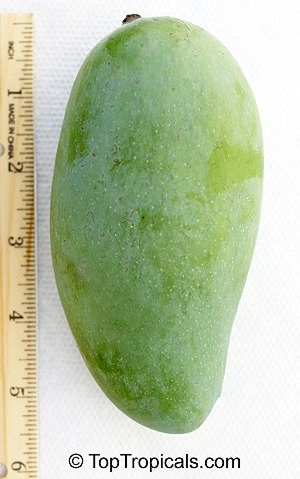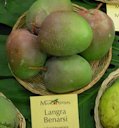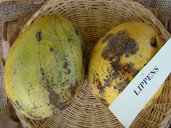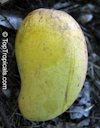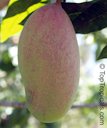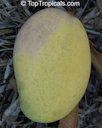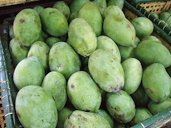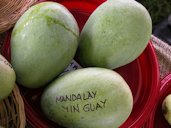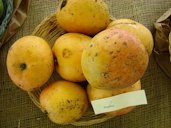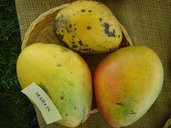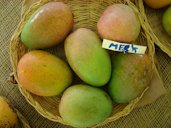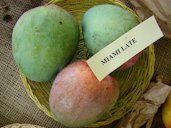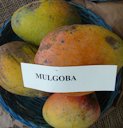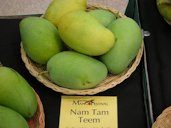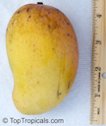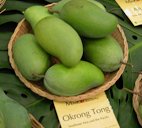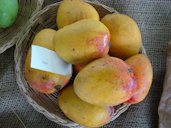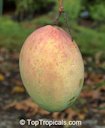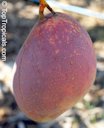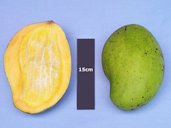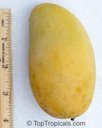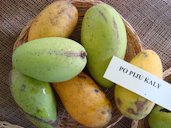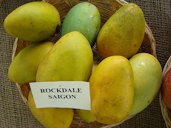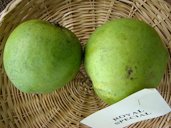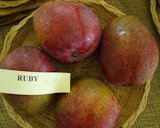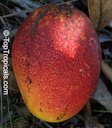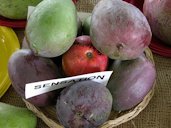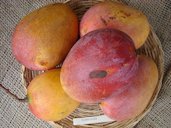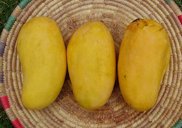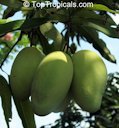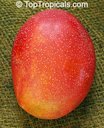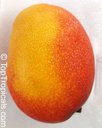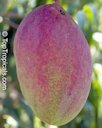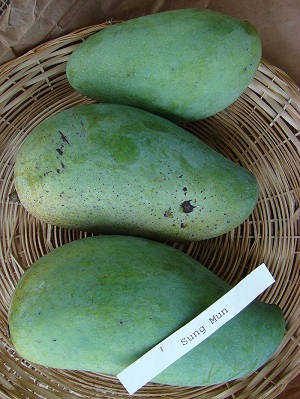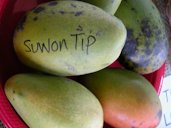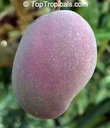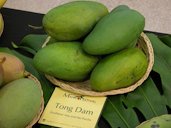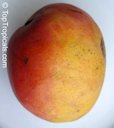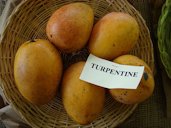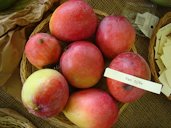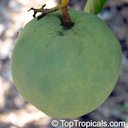Mango Varieties There are more than a thousand mango cultivars grown in the world, only 145 are represented here. Indochinese Types typically have polyembryonic seeds and fruit often lack attractive coloration (i.e., they are green, light green, or yellow). The fruit tend to be relatively resistant to anthracnose. Florida varieties of this group are grown commercially on a small scale and some are appreciated in home plantings. In many areas of the tropics, there are seedling mangos which do not clearly fit in either of these types. Some of these are 'Turpentine', 'Number 11', 'Madame Francis', and 'Kensington'. There are many mango varieties available in south Florida and many are appropriate for small and large home landscapes. Some characteristics of the most important Florida varieties are summarized in Table 1. 1 AB -CD- EF - GHI - JKL - MNO - P - RS - TVWZ * = 'Condo' Mango
Fig. 3. 'Alphonso'. "King of Mangoes", very sweet with fiberless pulp, rich in vitamin A and C, founded mainly in Devgad & Ratnagiri Districts of Maharashtra, India. This cultivar is available in Feb till end of May. 2
Fig. 9. 'Banganapalli'. The largest volume mango cultivar in the world, this medium-large fruit ripens to a golden-yellow exterior and a straw-yellow to golden-yellow interior. Very juicy, slightly tangy with little or no fiber and a creamy texture. It originates from the erstwhile princely state of Banganapalle, in present-day Andhra Pradesh, India. 2
AB -CD- EF - GHI - JKL - MNO - P - RS - TVWZ * = 'Condo' Mango Fig. 19. 'Carabao'. The Queen of Mangoes, Philippine Mango was confirmed by the Guinness Book of World Records as the world’s sweetest Mango. The Ataulfo (mango) and Manilita mango cultivars originated from the Philippines Mango variety. It can be traced back in the Manila-Mexico galleon trade in the years 1600-1800's. It was also known then as Manila Super-Mango. 2
Fig. 22. 'Choc Anon'. Choc Anon is known as the ever-bearing mango tree because of its potential to have a mango crop during the summer and winter. Some speculate that removing the summer crop may increase the chances of a winter crop by allowing the tree to save the energy that would have been used for fruit production in the summer. 2 AB -CD- EF - GHI - JKL - MNO - P - RS - TVWZ * = 'Condo' Mango
AB -CD- EF - GHI - JKL - MNO - P - RS - TVWZ * = 'Condo' Mango
Fig. 53. 'Himsagar'. Fig. 58. 'Irwin'. In Japan this variety is marketed as Apple Mango, and in the case of imports from Japan one needs to take care not to confuse it with the Apple Mango grown in the Philippines. 2 AB -CD- EF - GHI - JKL - MNO - P - RS - TVWZ * = 'Condo' Mango Fig. 60. Ivory. Also known as the Jingu Ivory mango, or Ivory mango, this long, thin mango is named for its resemblance to a young elephant's tusk. It has thin skin, smooth skin. The flesh contains very few fibers, and constitutes approximately 82 percent of the fruit. It was first introduced into Yunnan, China from Thailand in 1914. The actual tree that was the first to be imported still grows, and during one year produced almost 500 kg of fruit. 2 Fig. 75. Madame Francis. Large kidney shaped mango that ripens to a golden yellow colour with piquant flesh Commonly exported to the United States in spring; often a feature of NYC fruit stands. 2 AB -CD- EF - GHI - JKL - MNO - P - RS - TVWZ * = 'Condo' Mango
AB -CD- EF - GHI - JKL - MNO - P - RS - TVWZ * = 'Condo' Mango
AB -CD- EF - GHI - JKL - MNO - P - RS - TVWZ * = 'Condo' Mango
Fig. 126. Sindhi Mango cultivated in Sindhri town Mirpur Khas district, Sindh province of Pakistan 2 AB -CD- EF - GHI - JKL - MNO - P - RS - TVWZ * = 'Condo' Mango
Fig. 135. One of the most commonly sold mangoes in the world. has extremely long shelf life. Hard and oblong exterior. 2
AB -CD- EF - GHI - JKL - MNO - P - RS - TVWZ Further Reading Birthplace of Dashehari Mango, Biodiversity International pdf The rarest of rare mango in Malihabad, Biodiversity International pdf Back to Mango Page |
||||||||||||||||||||||||||||||||||||||||||||||||||||||||||||||||||||||||||||||||||||||||||||||||||||||||||||||||||||||||||||||||||||||||||||||||||||||||||||||||||||||
| Bibliography 1 Crane, Jonathan H., et al. "Mango Growing in the Florida Home Landscape." Horticultural Sciences Dept., UF/IFAS Extension, Original pub. Apr. 1994, Revised May 2003, May 2017, and Mar. 2020, AskIFAS, edis.ifas.ufl.edu/mg216. Accessed 10 Jan. 2018, 8 Aug. 2020. 2 "List of Mango Cultivars." Wikipedia, wikipedia.org. Accessed 4 Apr. 2016. Photographs Fig. 1,3,7,12,13,15,17,20,21,23,24,25,26,28,29,30,34,37,38,40,41,43,44,45,47,51,52,56,57,58,61,62,64,66,69,70,72,73,74,76,77,78,79,89,90,91,93,94 98,100,107,108,110,113,116,121,122,126,128,129,130,134,136,137,138,140,142,144,145 "Mango, Mangifera indica." Top Tropicals, toptropicals.com. Accessed 19 June 2014. Fig. 2,4,8,10,11,14,16,18,19,27,31,32,33,35,36,39,42,48,53,54,55,59,60,67,68,71,75,81,83,84,85,86,87,88,92,95,96,97,101,102,106,111,112,114,115, 117,118,123,124,127,131,132,133,134,139,141 Ghosh, Asit K, Thaumaturgist. "Display of the 'Anderson', 'Bailey's Marvel', 'Bennet', 'Cushman', Alphonso', 'Baptiste', 'Brooks', 'Cambodiana', 'Carabao', 'Carrie', 'Duncan', 'Du Dus', 'Eldon', 'Edward', 'Fascell', 'Ford', 'Gouveia', 'Himsagar', 'Hindi', 'Hindi Bessenara', 'Itamaraca Red', 'Kent', 'Lippens', 'Mandalay Yin Guay', 'Mulgoba', 'Nam Tam Teen','Ono', 'Osteen', 'Parvin', 'Pedda Rasam', 'Pope', 'Po Pyu Kalay', 'Pruter', 'Rockdale Saigon', 'Royal Special', 'Ruby', 'Sensation', Sophie Fry', 'Sung Mun','Suwon Tip', 'Tahar', 'Tom Dang', 'Tong Dam', 'Turpentine', 'Van Dyke' mangos at the Redland Summer Fruit Festival." Fruit & Spice Park, Homestead, Florida, 2007-2010, Wikimedia Commons, (CC BY-SA 3.0), GFDL, commons.wikimedia.org. Accessed 5 Apr. 2016. Fig. 5 Dwivedi,Suyash. "Amrapali Mango from India." Wikimedia Commons, 16 May 2017, (CC BY-SA 4.0), commons.wikimedia.org/wiki/File:Amrapali_Mango_(1).jpg. Accessed 10 July 2023. Fig. 6,33,63 Squam256. "'Angie','Early Gold', 'Jean Ellen' mangos." International Mango Festival at Fairchild Tropical Botanic Garden, Miami, Florida, 2007-2010, Wikimedia Commons, (CC BY-SA 3.0), commons.wikimedia.org. Accessed 7 Apr. 2016. Fig. 9 Chander, Siva. "Banganapalli. Banganapalli mangoes, illustrating variations in shape and size commonly found." Wikimedia Commons, 2015, (CC BY-SA 4.0), commons.wikimedia.org. Accessed 4 Apr. 2016. Fig. 46,49,50,91,99,103,104,105,109,119,120143 Maguire, Ian. "Mango Series." Tropical Fruit Photography Picture Archive, 2011, UF/IFAS/TREC, trec.ifas.ufl.edu. Accessed 28 July 2014. Fig. 22 Zai, Jahanzaib. "Chaunsa Mango, a famous variety of mango in Pakistan." Wikimedia Commons, 2005, (CC BY-SA 3.0), commons.wikimedia.org. Accessed 2 Apr. 2016. Fig. 65 Tuttle, Archibald. "José mango (from Réunion island). Deux mangues de la variété réunionnaise 'José'." Wikimedia Commons, 2010, (CC BY-SA 3.0), commons.wikimedia.org. Accessed 5 Apr. 2016. Fig. 80 Midori, Sakurai. "Manalagi mangoes, Taman Wisata Mekarsari, West Java, Indonesia." Wikimedia Commons, 2009, (CC BY-SA 3.0), GFDL, commons.wikimedia.org. (CC BY-SA 3.0). Accessed 5 Apr. 2016. Fig. 125 Mahmood, Khalid. "Sindhri, famous mango variety from Pakistan and Among the Best Tasted Mangoes of the World." Wikimedia Commons 2009, (CC BY-SA 3.0), commons.wikimedia.org. Accessed 5 Apr. 2016. Published 19 June 2014 LR. Last update 12 July 2023 LR |
||||||||||||||||||||||||||||||||||||||||||||||||||||||||||||||||||||||||||||||||||||||||||||||||||||||||||||||||||||||||||||||||||||||||||||||||||||||||||||||||||||||
